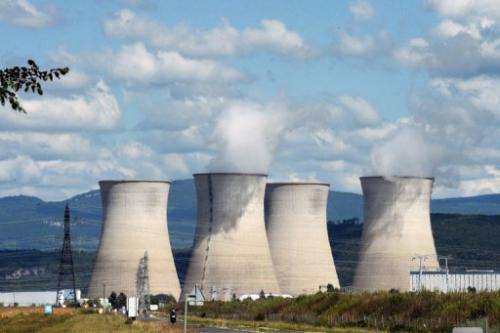
August 28, 2011. Mineral, VA. Ten years after Sept. 11, violent extremists still consider US nuclear power plants good targets. And those American power plants are just as at risk today as they were in 2001. That, Greenpeace said in an announcement this week, is indefensible. Another fact the activist group calls indefensible is what they call ‘dangerous old nuclear plants that are vulnerable to natural disasters like earthquakes and hurricanes, as well as deliberate attack’.
According to the Greenpeace warning, 108 million Americans live inside the danger zone of a nuclear reactor. That’s 50 miles in any direction from the core of a nuclear power plant. More than one in three Americans lives in that zone. The report also says the nuclear plant at the most risk from an earthquake is New York’s Indian Point. 17 million people live within 50 miles of that facility. With yesterdays Hurricane Irene following immediately on the footsteps of the Virginia 5.8 magnitude earthquake earlier this week, Americans are suddenly faced with a possible fate similar to the Japanese near the city of Fukushima.
Following the hurricane that struck Japan earlier this year, the Fukushima nuclear disaster was awarded the terrifying status of a Level 7 nuclear event, as measured on the International Nuclear Event Scale. Level 7 is the highest and most devastating level of nuclear catastrophes. So far, only one other nuclear disaster in history has registered as a Level 7 – Chernobyl.
Almost immediately after the disaster in Fukushima, Japanese officials continuously downplayed not only the damage, but the dangers Japan’s citizens were being exposed to. To this day, many government officials in Japan continue to quietly insist that no humans are in any danger whatsoever, with the exception of those involved in the initial explosions at the power plant. In fact, Japanese government officials have been quoted arguing that aside from some children who drank contaminated milk and contracted thyroid cancer, no human beings suffered as a result of the Chernobyl nuclear disaster.
In response, Russian scientist and Chernobyl expert Alexey V. Yablokov wrote an article warning Japanese officials of underestimating the dangers of exposure to radiation from the Fukushima tragedy. The Japanese media however, blacked-out the warning in an attempt to reassure their citizens of their ultimate safety. Only one Japanese news service, Kyoto, carried the article and only the English version.
In his warnings to Japan, and the rest of the world, Yablokov wrote:
“The analysis of the health impact of radioactive land contamination by the accident at the Fukushima Daiichi nuclear power plant, made by Professor Chris Busby (the European Committee of Radiation Risk) based on official Japanese Ministry of Education, Culture, Sports, Science and Technology data, has shown that over the next 50 years it would be possible to have around 400,000 additional cancer patients within a 200-kilometer radius of the plant.
This number can be lower and can be even higher, depending on strategies to minimize the consequences. Underestimation is more dangerous for the people and for the country than overestimation.”
Yablokov gave a number of suggestions to minimize the number of people hurt or killed in the coming decades due to radiation exposure. Among his suggestions were to increase the forbidden zone around the Fukushima reactors from 20 km to 50 km. He also suggested ongoing testing for citizens and distribution of radio-protectors and decontaminants. Giving his warning a sense of urgency, Yablokov also suggested Japanese healthcare facilities immediately improve their healthcare centers to deal with radiation exposure. He suggested building new facilities specializing in the cancers, diseases and other side effects associated with radiation exposure.
That brings us back to the Greenpeace warning this week. They mention Fukushima and how generations of Japanese citizens may have to live in a nuclear disaster zone. They also mention the North Anna nuclear facility in Virginia. North Anna is only 10 miles from last week’s earthquake epicenter. While dozens of US nuclear reactors experienced unusual events during the earthquake, the two North Anna reactors lost power and were forced to shut down. Owned and operated by Dominion Corporation, North Anna’s Westinghouse-built reactors are both still offline. In fact, five other US nuclear power plants are operating at reduced levels now.
According to Greenpeace, the most worrisome fact of all is this – the North Anna nuclear reactors were designed to withstand earthquakes ranging from 5.9 to 6.2. Last week’s earthquake only ten miles away registered at 5.8.
Subscribe to Whiteout Press – only 10 emails per week in your Inbox. It’s FREE and you can unsubscribe at any time. Simply enter your email address above and hit ‘Submit’.





